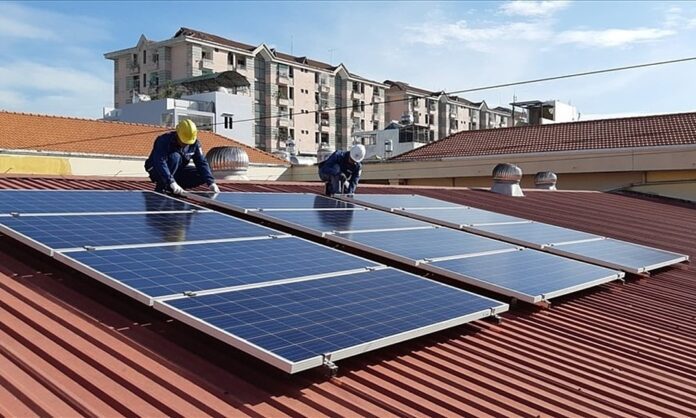My Neighbors Has Rooftop Solar. I Want It Too
An aerial view of Mumbai’s Bhandup suburb reflects an oasis of blue. Solar panels atop a cluster of buildings glisten in the sunlight amid a brown expanse of concrete.
It all began in 2018 when the Dheeraj Dreams 2 housing complex, overlooking Thane creek, commissioned a 200-kilowatt solar rooftop plant for their four 20-storeyed towers. It was the city’s largest such installation in a residential complex at the time.
“We had been looking to cut costs for a while,” Sanjay Tari, chairman of the residential society, told BloombergQuint. “When we looked at our bills, going solar was a no-brainer. Our annual electricity bills have now come down from Rs 52 lakh to just about Rs 19 lakh.”
Once Dheeraj Dreams 2 installed the panels, members from other housing societies in the neighbourhood started visiting to understand the benefits. “The cost saving on our electricity bills spoke for itself,” Tari said.
Now, four other housing societies—Dreams 1, Dreams 3, Mahavir Universe, and Mahavir Phoenix—located within half a kilometre of each other, have installed solar panels. Together, the 18 buildings have a peak capacity of over 700 kilowatts, enough to power a medium-sized industrial unit.
Still, the success of rooftop solar in Bhandup’s high-rise neighbourhood belies the full picture.
Installing rooftop panels is one among many policies to wean Indians away from dirty fossil fuels, and it dovetails with the nation’s plan to clean up the air. Yet, there is not much awareness and adoption is slow. India has only 6.5 GW of rooftop solar installations—way less than the 40 GW it had targeted by 2022. Maharashtra, India’s second-largest state by rooftop solar capacity, has less than 1 gigawatt of panels installed.
“Consumer awareness, even though gradually improving, is unfortunately very low,” said Gautam Das, chief executive of Oorjan Cleantech, a solar engineering, procurement and construction company that executed three of the five projects in Bhandup. “This is a new ecosystem and masses still don’t know the cost benefits that come with it.”
Neither government subsidies, nor rebates by city and state administrations have helped. The only means of publicity working so far is word of mouth.
Take Mumbai’s Nariman Point, for instance. Three years ago, Mittal Tower, a commercial office space next to Marine Drive, commissioned Avishakti Solar for a 120 kW solar installation. Soon, seeing the cost benefits, three adjoining commercial buildings by the same developer also had solar rooftop panels.
For consumers in Mumbai, the solar pitch is very clear: saving money. However, the commitment to go solar is more often prompted when they see a neighbour reap tangible benefits.
Consume Less, Save More
The cost advantages of rooftop solar panels come from a concept called net-metering. Installations are connected to the power grid of the electricity distribution company. All the electricity that is generated off the panels is fed into the main grid. That is then offset from whatever electricity is being consumed by the rooftop installation owner and a bill is generated.
For instance, if a building generates 100 units of electricity through solar and consumes 150 units from the grid in a month, it will only have to pay for 50 units. In cases where generation is higher than consumption, the surplus is carried forward by the power distribution company and adjusted in the next month’s bill.
Srikanth Swaminathan, a member of the managing committee for solar installations at Mahavir Phoenix complex in Bhandup, said their monthly consumption reduced from about 21,000-22,000 units of electricity to a net of 11,000 units. “The math is in our favour.”
The difference is more pronounced for housing societies. Discoms or power distribution companies have a tier-based system for tariffs, where those who consume above a certain threshold are charged a higher rate. This means that common electricity consumption in buildings from elevators, water pumps and lights costs more than that of individual flats.
Tari said that roughly the society pays Rs 15 per unit of electricity compared to about Rs 8 per unit for individual households. “When we put it that way, it became easier to convince the residents of the society,” he said.
Still, the rooftop solar societies of Bhandup, according to local real estate brokers BloombergQuint spoke to, mostly comprised residents who are financially better off than most Indians. For such upper middle-class and higher group of residents, incurring steep upfront costs for installing solar panels is manageable. But that may present a challenge for others.
Barriers To Entry
The installation at Dreams 2 had a total project cost of Rs 1.26 crore. While the society bore a cost of Rs 90 lakh, the remaining Rs 36 lakh came from the central subsidy provided by the Ministry of New and Renewable Energy.
Funding wasn’t a big hurdle as the society already had a fixed deposit of Rs 1 crore in a co-operative bank. It was able to avail financing against that fixed deposit through an overdraft facility.
Within three years, the society could recover the costs from savings and pay back the loan. “Now, we discount a monthly Rs 500 on society bills to each of the 546 flats,” Tari said.
Dreams 1 and 3, too, used a similar overdraft option to fund their own projects. On the other hand, Mahavir Phoenix was able to raise funds from its residents. “Most large societies are required to keep a fixed deposit account. It shouldn’t be hard for them to avail overdraft on that for solar (plants),” Swaminathan said.
That doesn’t change the fact that going solar is a costly affair. “Not only is it mostly unaffordable, there’s also a lack of easy financing options,” said Vinay Rustagi, managing director of the renewable market research firm Bridge To India.




